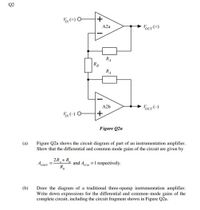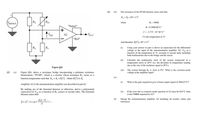
Introductory Circuit Analysis (13th Edition)
13th Edition
ISBN: 9780133923605
Author: Robert L. Boylestad
Publisher: PEARSON
expand_more
expand_more
format_list_bulleted
Concept explainers
Question
answer the question

Transcribed Image Text:Q2
Vi (+) O-
VOUT (+)
A2a
RA
RA
A2b
VOUT-)
Figure Q2a
(a)
Figure Q2a shows the circuit diagram of part of an instrumentation amplifier.
Show that the differential and common mode gains of the circuit are given by
2R,+R
and 4,cu =1 respectively.
R,
Draw the diagram of a traditional three-opamp instrumentation amplifier.
Write down expressions for the differential and common-mode gains of the
complete circuit, including the circuit fragment shown in Figure Q2a.
(b)

Transcribed Image Text:Q2
(d)
The resistance of the PTI00 element varies such that
RR+ BT+CT
BRIDGE
Ro
R
where
R,- 1002
"Sense"
C=-5.75 - 10'Q'C
Vor
VOUT
A2
Tis the temperature in "C
"Ref"
And therefore 8(r)- 8T +Cr*
Ro
Ro
Using your answer to part e) derive an expression for the differential
voltage at the input of the instrumentation amplifier A2. V as a
function of the temperature in "C, accurate to second order including
both nonlincarities due to the bridge and the sensor.
()
(u)
Calculate the nonlincarity eror of the system (expressed as a
temperature eror) at 20°C (ie. the deviation in temperature reading
due to the size of the nonlinear signal at 20°C).
Figure Q2e
Figure Q2e shows a resistance bridge incorporating a platinum resistance
thermometer, PTI00", which is a resistor whose resistance R, varies as a
(i) The current through R, is Ima at O°C. What is the common-mode
voltage at the amplifier input?
Q2
(c)
(e)
function temperature such that R, -R +8(T) where 8(T)<R
()
What is the gain required to give a lincar output signal of 100mVrC?
Amplifier A2 is the instrumentation amplifier you described in part b)
By making use of the binomial theorem or otherwise, derive a polynomial
expression for V as a function of R, correct to second order. The binomial
theorem states that:
(ii) If the error due to common mode rejection of A2 must be 001'C what
is the CMRR roquired for A2?
Design the instrumentation amplifier A2 including all resistor values and
tolerances.
(1+x) =t+ pr+ Plp-1),
2!
Expert Solution
This question has been solved!
Explore an expertly crafted, step-by-step solution for a thorough understanding of key concepts.
This is a popular solution
Trending nowThis is a popular solution!
Step by stepSolved in 3 steps with 3 images

Knowledge Booster
Learn more about
Need a deep-dive on the concept behind this application? Look no further. Learn more about this topic, electrical-engineering and related others by exploring similar questions and additional content below.Similar questions
- A bbhosted.cuny.edu/webapps/assessment/take/launch.jsp?course assessment_id3 1787700 1&course_id%3 1950256 1&content id3=_55349866_1&step=null ¥ Question Completion Status: Given a truth table below with the first two columns of truth values provided: f(p,q) T F 4 ? Which of the answers below contains the truth values for the third column when f(p,q) = (p@q)→ (pnq)? Column 3 Column 3 Column 3 Column 3 Column 3 truth truth values: truth values: truth values: truth values: values: 1 T 1 T 1 F 1 T None of the other 1. O 2 F O answers provided is 2 F 2 T 2 T correct. F 3 T 3 F 3 F 4T 4. 4 4 T 4 Save All Answers Click Save and Submit to save and submit. Click Save All Answers to save all answers. a 99+ P Type here to search FTFF 3, 立 2.arrow_forwardMy Signals and Systems question is attached. I don't understand how to figure out parts b and c mostly, but help with a would also be appreciated. The problem is from Alan V. Oppenheim by Alan S. Willsky. Thank you!arrow_forward
Recommended textbooks for you
 Introductory Circuit Analysis (13th Edition)Electrical EngineeringISBN:9780133923605Author:Robert L. BoylestadPublisher:PEARSON
Introductory Circuit Analysis (13th Edition)Electrical EngineeringISBN:9780133923605Author:Robert L. BoylestadPublisher:PEARSON Delmar's Standard Textbook Of ElectricityElectrical EngineeringISBN:9781337900348Author:Stephen L. HermanPublisher:Cengage Learning
Delmar's Standard Textbook Of ElectricityElectrical EngineeringISBN:9781337900348Author:Stephen L. HermanPublisher:Cengage Learning Programmable Logic ControllersElectrical EngineeringISBN:9780073373843Author:Frank D. PetruzellaPublisher:McGraw-Hill Education
Programmable Logic ControllersElectrical EngineeringISBN:9780073373843Author:Frank D. PetruzellaPublisher:McGraw-Hill Education Fundamentals of Electric CircuitsElectrical EngineeringISBN:9780078028229Author:Charles K Alexander, Matthew SadikuPublisher:McGraw-Hill Education
Fundamentals of Electric CircuitsElectrical EngineeringISBN:9780078028229Author:Charles K Alexander, Matthew SadikuPublisher:McGraw-Hill Education Electric Circuits. (11th Edition)Electrical EngineeringISBN:9780134746968Author:James W. Nilsson, Susan RiedelPublisher:PEARSON
Electric Circuits. (11th Edition)Electrical EngineeringISBN:9780134746968Author:James W. Nilsson, Susan RiedelPublisher:PEARSON Engineering ElectromagneticsElectrical EngineeringISBN:9780078028151Author:Hayt, William H. (william Hart), Jr, BUCK, John A.Publisher:Mcgraw-hill Education,
Engineering ElectromagneticsElectrical EngineeringISBN:9780078028151Author:Hayt, William H. (william Hart), Jr, BUCK, John A.Publisher:Mcgraw-hill Education,

Introductory Circuit Analysis (13th Edition)
Electrical Engineering
ISBN:9780133923605
Author:Robert L. Boylestad
Publisher:PEARSON

Delmar's Standard Textbook Of Electricity
Electrical Engineering
ISBN:9781337900348
Author:Stephen L. Herman
Publisher:Cengage Learning

Programmable Logic Controllers
Electrical Engineering
ISBN:9780073373843
Author:Frank D. Petruzella
Publisher:McGraw-Hill Education

Fundamentals of Electric Circuits
Electrical Engineering
ISBN:9780078028229
Author:Charles K Alexander, Matthew Sadiku
Publisher:McGraw-Hill Education

Electric Circuits. (11th Edition)
Electrical Engineering
ISBN:9780134746968
Author:James W. Nilsson, Susan Riedel
Publisher:PEARSON

Engineering Electromagnetics
Electrical Engineering
ISBN:9780078028151
Author:Hayt, William H. (william Hart), Jr, BUCK, John A.
Publisher:Mcgraw-hill Education,